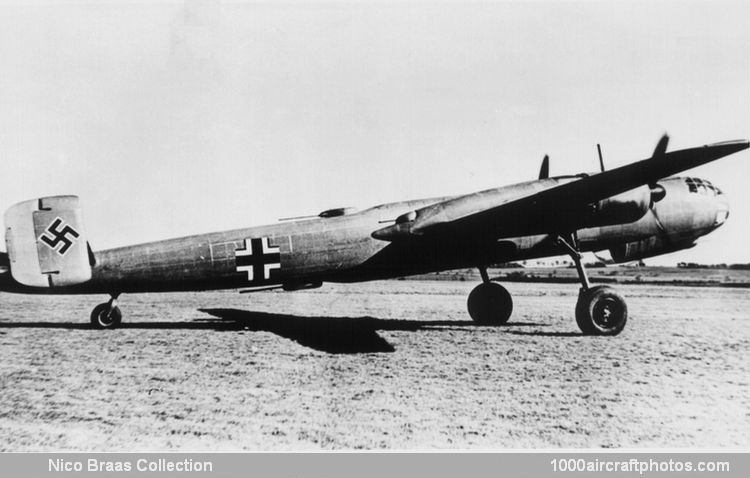02/28/2015. Remarks by Johan Visschedijk: "During the winter of 1939-1940, four companies received from the RLM the outline specification for a new medium bomber. This was known as the B medium bomber type which was to have a maximum speed of 373 mph (600 kmh) and carry a 8,820 lb (4,000 kg) bomb load to any part of the British Isles from French or Norwegian bases. In addition, a pressurized crew compartment, remote-controlled armament, and dive-bombing ability were required. For power, either two Junkers Jumo 222 or two Daimler-Benz DB 604 24-cylinder liquid-cooled engines, which were under development for the 2,500 hp class, were to be used.
By July 1940, the four firms submitted their design proposals, the Arado Ar 340, Dornier Do 317, Focke-Wulf Fw 191, and the Junkers Ju 288, with the result that the Fw 191 and Ju 288 were selected for full development, the Ar 340 was eliminated, and the Do 317 was put on a low priority development contract. A condition of the Focke-Wulf contract was that the Fw 191 should be designed with electrical systems throughout; this ill-founded and illogical directive precluded any hydraulic or similar systems, however appropriate they might be, and later earned the aircraft the appellation of Fliegendes Kraftwerk (flying power-station).
Under the leadership of Dipl-Ing E. Kösel, the Fw 191 was designed as an all-metal, twin-engined aircraft possessing clean lines. The shoulder-mounted wing, which was to carry two Jumo 222 engines, had a parallel-chord center section and an approximately equi-taper planform outboard of the engines. In addition to ailerons divided chordwise into two sections near each wing tip, there were special combination landing flaps/dive-brakes (designed by Hans Multhopp) divided chordwise into four sections along each wing trailing edge. From the engine nacelles (which projected slightly beyond the wing trailing edge) extended the main landing gear members which swung rearwards and turned through 90 deg for retraction into the bottom of the nacelles. The tail wheel retracted forwards and was covered by two small doors. Twin fins and rudders, of an almost square shape, were carried at the tips of the tail plane which had moderate dihedral.
In the fuselage, behind the crew's pressurized nose compartment, was situated the bomb bay with long, folding bomb doors, while above this bomb bay were the main fuel tanks. These were supplemented by tanks in the inboard wing sections. The hemispherical fuselage nose consisted of a framework with glazing to provide a view for the pilot and bombardier/navigator, the latter lying prone for bomb aiming and firing the chin mounted turret guns. Above and just behind the glazed nose section was a clear Plexiglas canopy which provided a sight station for navigation and gave the radio operator a rear view when firing the three upper gun barbettes (two at the rear of the engine nacelles and one on top of the rear fuselage). Beneath the nose was a gondola with a glazed rear step which provided a view for the flight engineer when he lay prone to fire the rear ventral gun barbette. All armament was to be remotely-controlled.
By the time construction started on the Fw 191 V1 and V2 prototypes late in 1940 it was obvious that the proposed Jumo 222 engines were far from ready and so the two prototypes were fitted with less powerful 1,600 hp BMW 801A air-cooled radial engines to begin flight testing. Furthermore, these prototypes had no cabin pressurization, and only dummy armament installations. With Dipl-Ing Mehlhorn at the controls, the Fw 191 V1 first flew early in 1942 and, after ten flights, was joined by the similar Fw 191 V2. The flight tests with the Fw 191 V1 and V2 machines proved very disappointing but this did not reflect any incompetence on Focke-Wulf engineers. Much of the trouble stemmed from the enforced under-powering, while the aircraft had suffered a weight penalty due to the profusion of electrical equipment which was also a source of constant breakdown (which spoke poorly of its chances under combat conditions).
More surprising, Multhopp's special flaps were susceptible to serious flutter. No-one at Focke-Wulf had any illusions about the design and, late in 1942, after repeated requests, permission was given to abandon work on the Fw 191 V3, V4, and V5 prototypes and to modify and complete the V6 machine. The most important modifications were that all the main systems were made hydraulic and two specially-prepared Jumo 222 engines were fitted although these were still only producing less than 90% of their design power. Thus modified, the Fw 191 V6 made its maiden flight in the spring of 1943 with Flugkapitän Hans Sander at the controls and, shortly after, made its last flight, from Delmenhorst to Wenzendorf.
In 1942, the Daimler-Benz DB 604 engine development had been abandoned and development prospects for the Jumo 222 engine appeared bleak because of the shortage of special metals. With no other 2,500 hp class engine available, therefore, the whole B medium bomber program was officially shut down."
